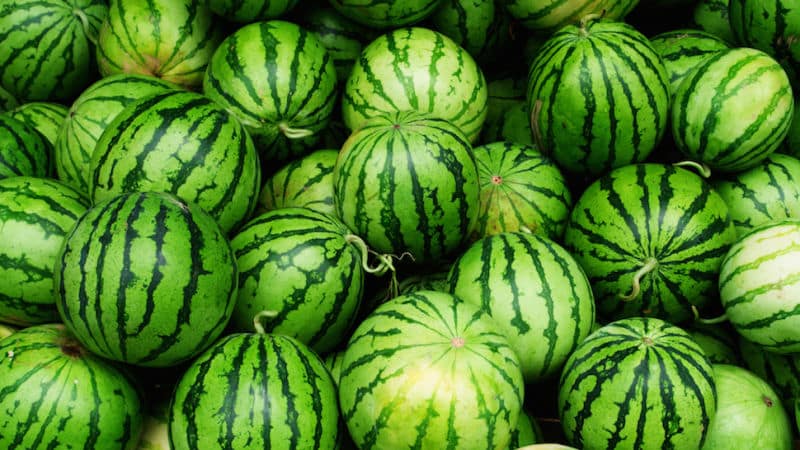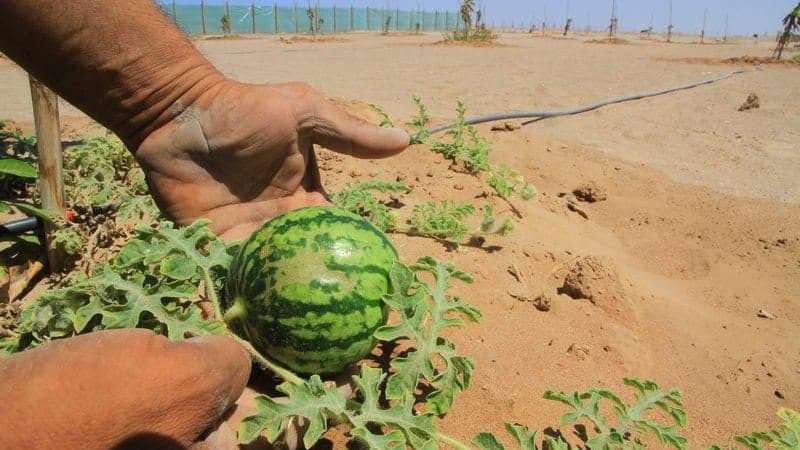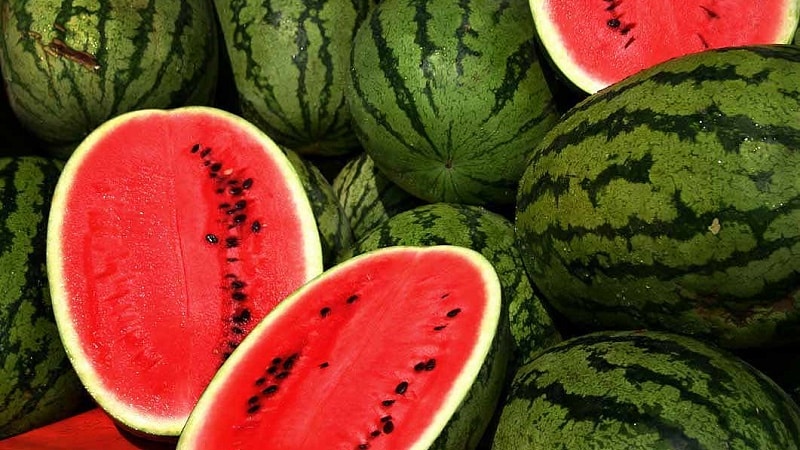What is a watermelon: what family do the fruits belong to, what are they and how are they useful?
Watermelon, whose beneficial properties are combined with an exotic taste and delicate aroma, is loved by children and adults. The juicy pulp perfectly quenches thirst on hot summer days and is used in diets for weight loss. However, in some cases, watermelon can bring not only benefits, but also serious harm to health.
The article will tell you what family it belongs to, how it grows, the beneficial properties of the fruit and contraindications for eating it.
What is watermelon: a berry, fruit or vegetable
Watermelon is an annual herbaceous plant of the Watermelon genus of the Cucurbitaceae family. It belongs to the melon crops. From a botanical point of view, watermelon fruits are berries.
However, due to the discrepancy between the characteristics of the fruit and the standard description and photo of the berries (the rind is too thick), watermelons are called pumpkin or “false” berries.

What it looks like, what they are, what color
The fruits differ in shape, size and color depending on the variety. Pumpkin has a spherical, oval or flattened shape. Weighs from 2 to 25 kg. The color of the hard crust is most often green with darker stripes or spots.
The surface is smooth in most cases. Between the rind and the juicy pulp there is a white layer ranging from a few millimeters to 5 cm thick. The pulp of watermelons is red, pink or raspberry in color, juicy, sweet and aromatic.The seeds, 5 to 14 mm in size, are flat, edged, dark brown or white, and are found in the pulp.
Thanks to selection, a large number of varieties and hybrids of watermelon have been obtained. Their fruit weight can range from 10 g to 125 kg. The color of the fruit's rind can be not only dark green or striped, but also black, white, yellow, spotted or marbled. The flesh is also white, yellow or creamy orange.
There are also unique varieties of watermelons. For example, a representative of the Densuke variety has a rich black color without a single stripe; it is grown only on the Japanese island of Hokkaido.
Seedless watermelons are also common, including those with yellow flesh. This variety was bred for those who are tired of extracting seeds.
Interesting! Currently, Japanese breeders have developed new varieties with a traditionally dark green striped color, but with a square and pyramid shape.
Origin and distribution

South Africa is considered the birthplace of watermelon. Scientists believe that its ancestor is Citrullus ecirrhosus (tsamma melon), which grows in the Kalahari Desert and still serves as a source of water for the Bushmen. These wild fruits are small in size and have bitter pulp. Watermelons began to be grown 4 thousand years ago in the northern part of Africa, precisely in the Nile Valley. Over time - in the Mediterranean, the Middle East, India and China.
In the 20th century BC in Ancient Egypt, the fruits were placed in the tombs of the pharaohs, believing that they would be a source of food in the afterlife. The seeds were discovered in the tomb of Tutankhamun. Watermelon was depicted on the walls of tombs and was often mentioned in ancient medical recipes.
In the 10th century, watermelon began to be grown in China; the seeds were brought by merchant ships.The Chinese called it the melon of the West and considered it a medicinal remedy. Today, more watermelons are grown in China than anywhere else in the world.
Watermelons were brought to medieval Europe during the era of the Crusades. On the territory of modern Russia, the fruits began to be grown in the 13th-14th centuries.
Now watermelons are cultivated in China, America, Japan, Turkey, Iran, Egypt, Russia, Uzbekistan and Ukraine.
Features of the plant and its root system
The stem is thin, creeping and highly branched, long (up to 5-6 m), from it there are shoots of the first and second order and clinging tendrils. The main structural elements of the stem are powerful vascular bundles that perform a water-carrying function.
The leaves are gray-green, hairy, dissected into seven broad lobes.
The flowers are often hermaphroditic, but there are female and male, have a field-yellow color, and consist of five petals.
The root system is powerful, consisting of a main root, lateral roots bearing a mass of thin branches. The main root usually grows vertically down to 1 m, the lateral ones are located horizontally at a depth of 20-30 cm, reaching a length of 4-6 m. The root system covers up to 8-10 m³ of soil, and the total length of the main roots is 60 m. The horse system has a large suction force.
Composition and properties of fruits

The juicy pulp has an impressive chemical composition in terms of the number of vitamins and minerals, which contains vitamins: groups B, A, C, E, H, PP, as well as minerals: potassium, calcium, phosphorus, sodium, magnesium, iron, lycopene and plant fiber.
Attention! Watermelon contains a large amount of water: 100 g of pulp contains 90 g of water.
The fruit has numerous positive properties:
- helps remove toxins and waste from the body;
- enhances intestinal motility;
- relieves swelling;
- without irritating the urinary tract, it removes sand and small stones from the kidneys;
- prevents the development of gout, arthritis, atherosclerosis and some cardiovascular diseases.
It has an anti-inflammatory, choleretic and restorative effect on the human body, normalizes metabolic processes.
Attention! If the fruit contains nitrates, then its flesh is bright red with yellow veins, the seeds are white, and the peel has soft areas.
Calorie content and BZHU
Calorie content is 25-30 kcal per 100 g of product: proteins - 0.6 g, fats - 0.1 g, carbohydrates - 5.8 g.
Benefits of watermelon for men, women and children

The main property of watermelon juice is its cleansing effect. It removes toxins, moisture and fats from the body, which is actively used by women. Eating watermelon relieves swelling of the legs, removes bags under the eyes, and relieves heartburn. During the menstrual period, it helps to cope with general weakness, pain and cramps in the lower abdomen, headaches, and reduces blood loss.
The components citrulline and lycopene have a stimulating effect on the sexual function of men: watermelon juice increases sexual desire.
The fruit is rich in vitamins and minerals that children need. It has a general strengthening and immunostimulating effect on the children's body. Low calorie intake is important for overweight children.
During pregnancy and pregnancy
During pregnancy, watermelon should be consumed environmentally friendly, without nitrates. A small slice of fruit for breakfast in the first trimester of pregnancy reduces unpleasant signs of toxicosis (vomiting, nausea, heartburn).
Regular use in the later stages it helps fight leg cramps.Pregnant women should consume up to 800 g of this product per day, since exceeding this norm can lead to problems with the genitourinary system.
When breastfeeding your baby Watermelon should be excluded from the diet if you are not sure that the fruit does not contain nitrates.
When losing weight
Watermelon diet is an effective method that allows you to lose weight in a few weeks. Due to its low calorie content and the appearance of a feeling of satiety for a long time, it is used in mono-diets and in the form of fasting days once a week.
This diet is usually well tolerated due to the presence of a large amount of water, natural sugars and an abundance of nutrients in watermelon. The optimal consumption rate for people losing weight is 1 kg of pulp per 10 kg of weight.
Rules and norms of consumption

Despite the usefulness of the fruit, its excessive consumption can negatively affect health, so follow the rules and norms of consumption:
- eat in the morning or afternoon, since eating before bed can lead to frequent visits to the toilet and sleep disturbances;
- do not eat watermelon before or after the main meal, as digestive problems may arise, optimally two hours before or after meals;
- watermelon is not combined with other products;
- Healthy adults eat watermelon in unlimited quantities until they feel full.
Infants and children under 3 years of age are prohibited from eating watermelon due to the possible development of allergic reactions.
It is recommended to give children from 3 to 5 years of age no more than 200 g of pulp per day, since the fruit can cause digestive upset or harm the child’s genitourinary system. In this case, the pulp is cut out from the middle of the fruit, since nitrates accumulate there the least.In addition, the product is given only during its ripening period - late August - mid-September.
Children aged 5 years and older can eat from 200 to 800 g of pulp.
Contraindications
There are diseases for which it is worth completely excluding the fruit from the diet:
- serious dysfunction of the liver and kidneys;
- problems with urination;
- kidney stones with a diameter of more than 4 mm;
- diarrhea and persistent colitis;
- type 2 diabetes mellitus;
- increased acidity or ulcers of the stomach, duodenum;
- individual intolerance.
The most popular varieties
We bring to your attention an overview of the most famous varieties of watermelon.
Astrakhan
This variety has been popular since Soviet times. It has a round, slightly oval shape, light yellow, slightly blurry stripes on a dark green background. It has a sweet, rich taste, rich vitamins, perfectly quenches thirst.
Ogonyok
Variety can also be grown in northern regions. It is distinguished by its spherical shape and dark, green, uniform color of the peel. Weighing up to 2 kg. Very sweet, with delicate granular pulp, almost without seeds.
Chill
One of the most famous late varieties, it can only be bought at the end of September. It is distinguished by its huge dimensions (up to 25 kg). It has an elongated oval shape, thick striped skin and bright red sugary flesh.
Lunar
An original, memorable hybrid with bright lemon-colored pulp. The main difference is the color and tenderness of the pulp, the unique taste, which mixes notes of lemon, honey and vanilla.
Conclusion
Watermelon is rich in vitamins and nutrients, but it will bring benefits and not harm to the human body only if all the rules and regulations for eating it are followed.